skip to main |
skip to sidebar
Click on any picture below to see an uncropped image.
Events of Sunday 4th May 2014
Introduction
This was my first visit to Rakhine State and I need to do more study to understand its turbulent history better. However, to be going on with, here’s what I gleaned from my Tour Itinerary:-
Mrauk U, once known as Myo Haung, was Rakhine’s capital in the 15th century and was one of the richest cities in Asia and a major trading centre, making it the envy of the Bengalis, the Moguls and the Burmese. During this period, the population of Mrauk U was at least 150,000. The decline was triggered by two major earthquakes in 1761 and 1762 and, by 1784, the famous King Bodawpaya of Burma had annexed Rakhine. Following the first Anglo-Burman war in 1826, the British moved the administrative centre to Sittway and Mrauk U became a backwater, its wealth gone but with a legacy of many monuments and pagodas hinting at its former glories.
Although Burmese is the official language, Rakhine is widely spoken. My best attempt at pronouncing Mrauk U is 'em-rah-oo'. The population is now only around 7,000 and there’s significant poverty. There are very few ‘sealed’ roads with tarmac. Most routes are crushed rock and sand, making the small ‘Jeep’ assembled in Myanmar a practical form of motor transport and, of course, there aren’t many of those. For our tours, we had a friendly driver with a second-hand ‘Jeep’ and my guide Mr. Myint Zaw.
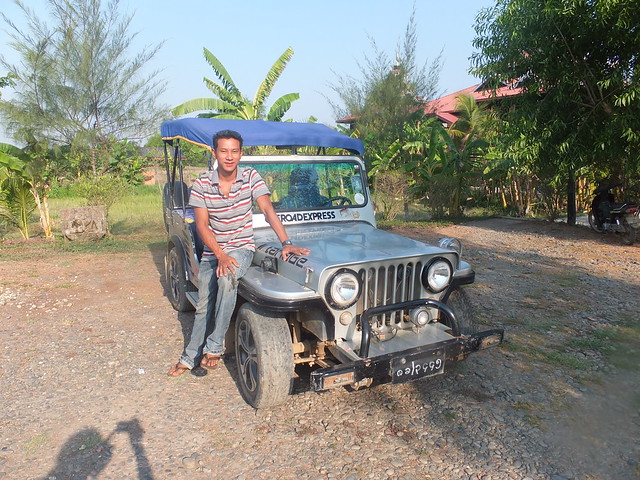 The 'Jeep' and driver which took me and my guide around Mrauk U.
The 'Jeep' and driver which took me and my guide around Mrauk U.
Mrauk U Sunday Market
First, we had a walking tour of the local market. Anywhere in Asia, you can find these vibrant markets with a remarkable range of produce offered under conditions which would send any European Public Health Inspector into apoplexy. Most of the vegetables I couldn’t identify and I needed explanations for some of the other foods. There were live crabs, tree rats, dried fish, cows intestines, various cuts of beef, staples like eggs and lots and lots of curry powder.
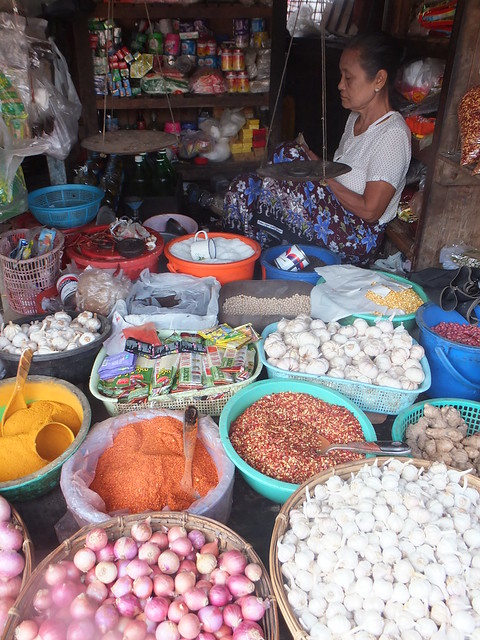
This well set-up stall holder had a conventional, 2-pan balance.
Some of the vendors used the familiar 2-pan balance to weigh the products but most seemed to prefer a more portable version with only a single pan and a balance arm made of wood, looking rather like a small truncheon. I think I’d be a little suspicious of the measurements provided by these single-pan balances.

A single-pan balance in use.
New clothing, mainly from China or Thailand was on sale but there was also second-hand clothing which was displayed in heaps on sheets laid on the ground, for prospective customers to rummage through.
 The second-hand clothing stall in Mrauk U market.
The second-hand clothing stall in Mrauk U market.
Football Ground
The Burmese are keen on football, although their enthusiasm sometimes exceeds their playing talent. As we left town, we passed a match in progress at the football ‘stadium’ - a large pitch of beaten earth with goalposts. With a local festival approaching, a series of fixtures had been arranged. A canopy had been provided over the V.I.P. seating area but most of the sizeable crowd were happy to stand along the touch line shouting their encouragement. A café with tables and chairs near one corner of the pitch seemed to be doing a good trade. There were also supporters sitting on top of an ancient wall on the far side of the road. This wall was actually the outer wall of the former Royal Palace.
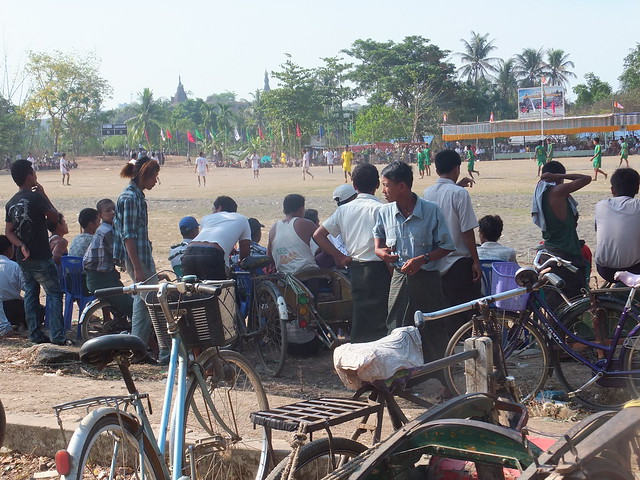 The football match drew a sizeable crowd.
The football match drew a sizeable crowd.
Miphara-gri Cave Temple
The day then took on the familiar format that regular readers may recognise which I call "Jan looked at a load of old temples". We continued on dreadful roads to a hill topped with a ruined cave temple with two stone Buddha images. This was Miphara-gri, the Queen’s Cave Temple donated by Queen Saw Thandar. From the summit, we had splendid views of the Koe-thoung Pagoda a few hundred yards away, which was donated by the Queen's husband, King Tikkha.
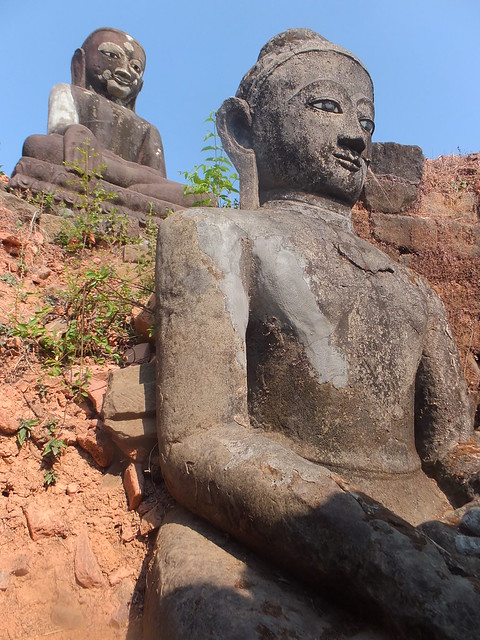 The two Buddha images at Miphara-gri.
The two Buddha images at Miphara-gri.
We could also see the track bed of a new railway under construction, with a part-built station building. The local people are unhappy that this railway has been located so close to these important historic and religious sites.
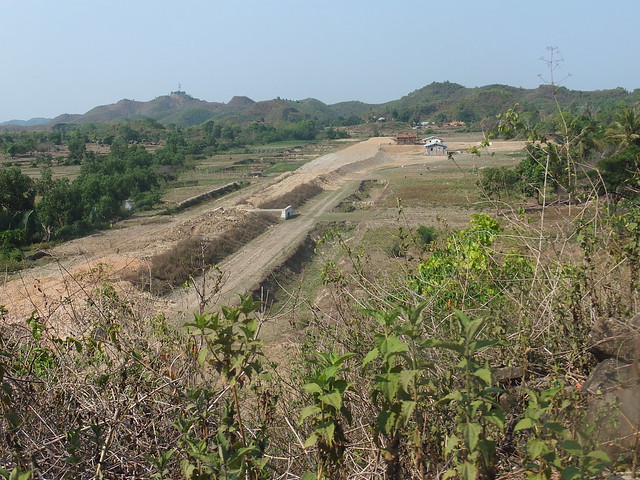 View of the new railway under construction from Miphara-gri.
View of the new railway under construction from Miphara-gri.
Koe-thoung Temple
I was already tired from the heat and the climbing at Miphara-gri as the Jeep took us to nearby Koe-thoung Temple, a very impressive site on which excavation and restoration only started in the last twenty years. It was built by King Tikkha in 1553 and it's the largest temple in Rakhine State - the rectangular base measures 250 feet by 230 feet.
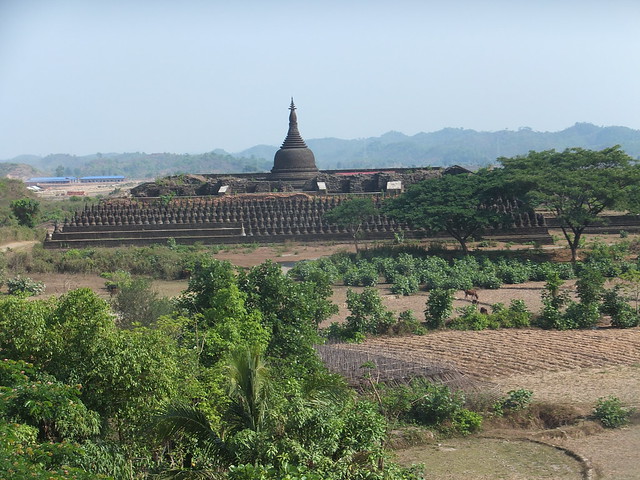 View of the Koe Thaung Pagoda from the Miphara-gri Temple.
View of the Koe Thaung Pagoda from the Miphara-gri Temple.
Koe-Thaung is often referred to as the 'Rakhine Borobudur'. Whilst perhaps not as impressive as Borobudur, I can understand the naming (my own visit to Borobudur in Java is described here with a link to my photographs).
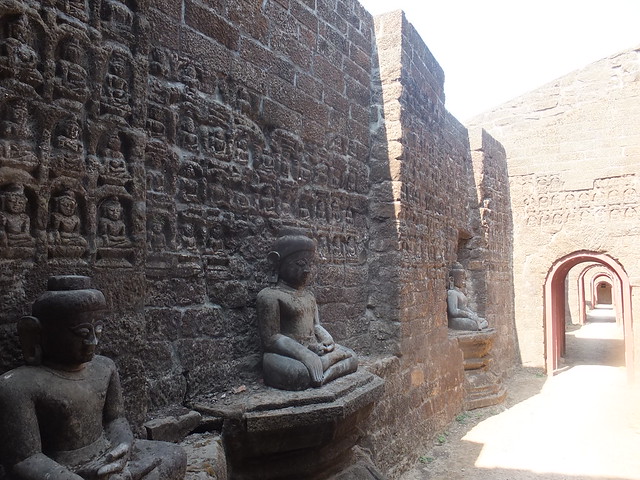 The Lower Vaulted Passage at Koe-thaung, with stone relief Buddha images 9 inches tall covering the walls.
The Lower Vaulted Passage at Koe-thaung, with stone relief Buddha images 9 inches tall covering the walls.
Phra-ouk Pagoda
Returning to Mrauk U, we passed through wooded areas covered with pagodas, somewhat reminiscent of the Bagan pagodas but set in a hilly landscape and incorporating Rakhine architectural features. We paused at Phra-ouk Pagoda, donated by King Phalaung in 1571 (a few more steps for me to climb). The upper part of this pagoda had been destroyed but is now restored. It is notable for the 29 niches facing outwards on the lower terrace, each containing a Buddha image. The main chamber houses a sandstone Buddha image over 12-foot tall which, in recent times, has been painted gold.
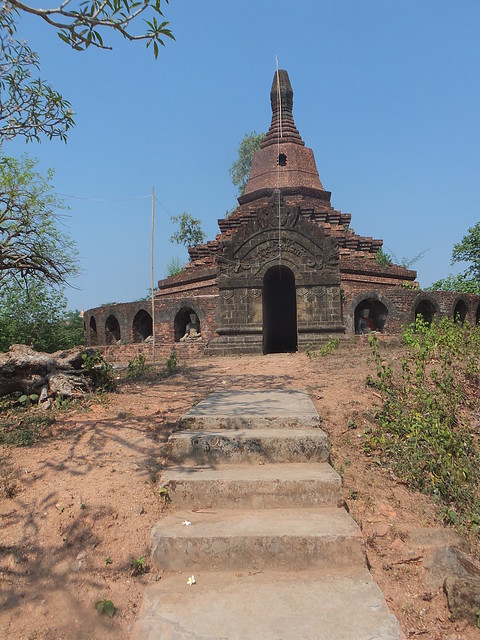
Phra-ouk Pagoda.
The Museum
Some of the more important relics from all the sites around Mrauk-U are now on display in the Museum, which has been built in the grounds of the former Royal Palace. Although the walls of the Royal Palace remain, all the buildings have been lost. After an interesting time in the Museum (alas unrecorded because photography was not allowed) it was agreed that the Guide and Driver would take me back to my Resort so that I could rest before continuing at 4.30 p.m. when the heat of the day was starting to abate.
Shaitthaung Temple
In the late afternoon, the tour continued at the extensive and impressive Shaitthaung Temple, noted for over 80,000 Buddha images, donated in 1535 by King Min Ba Kyi. The stone temple complex was built on a rectangular platform 225 feet by 180 feet by 1,000 workers. We entered via a covered flight of tiled steps leading to a large, fairly modern extension abutted onto the original complex.
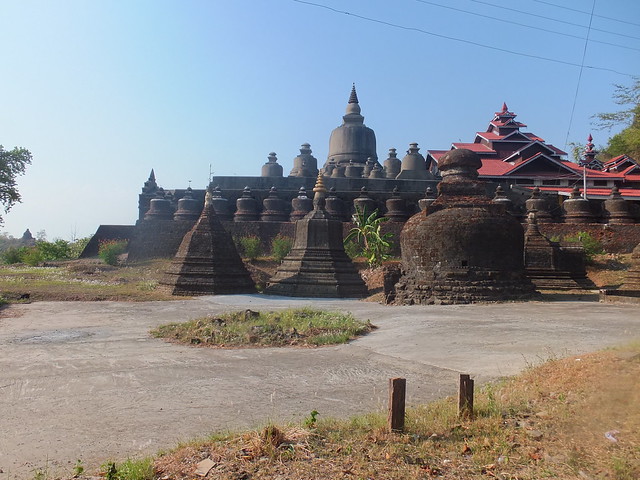 Shaitthaung Temple.
Shaitthaung Temple.
The original complex features a number of internal passages richly decorated with reliefs and carved figures.
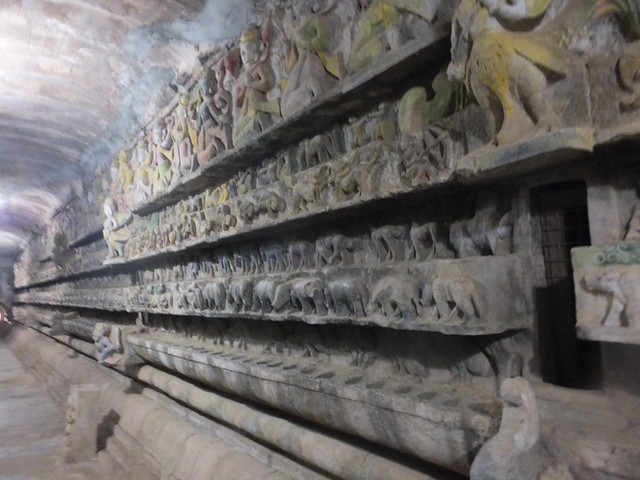 One of the richly-decorated internal passages.
One of the richly-decorated internal passages.
The design and construction of this remarkable complex was supervised by the revered Shun-nge Sara U Mra Wah.
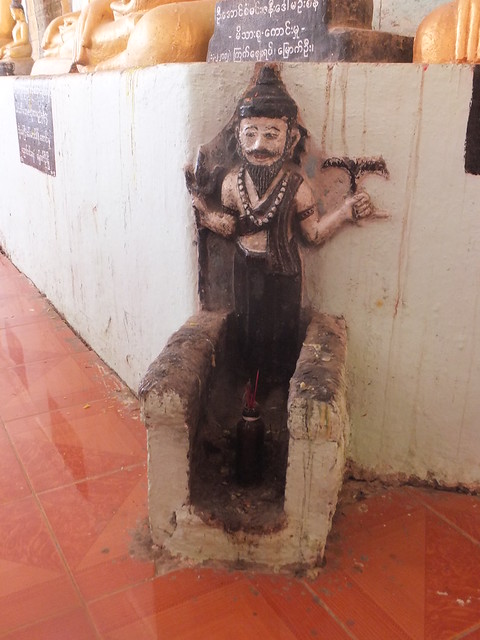 Statue of Shun-nge Sara U Mra Wah.
Statue of Shun-nge Sara U Mra Wah.
The temple contains many treasured relics. As an example, the Ananda Chandra Pillar is a square, stone pillar, over nine feet in height with each face 2 feet 4 inches wide. Three of the four faces are engraved with scripts dating, respectively, from the 6th, 8th and 10th century.
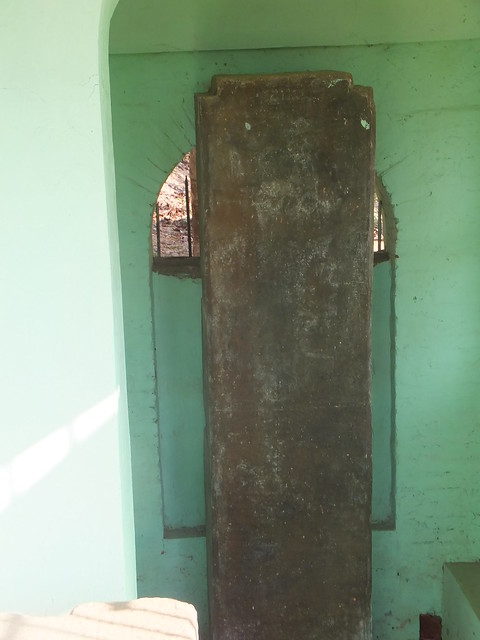
The Ananda Chandra Pillar.
Lay-myut-hna Temple
We then explored the Lay-myut-hna Temple nearby. This was built in 1430 by King Saw Mwan from sandstone blocks and has four entrances. The area was overlooked by the famous Htuk Kant Thein Temple but we agreed to defer our visit here until the following day. I was appalled that three helicopter landing pads had been built here, to allow visiting dignitaries ready access to Mrauk U from Sittwe.
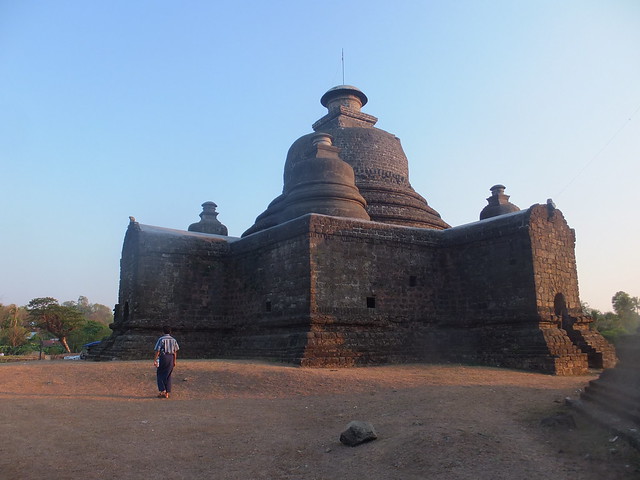 Lay-myut-hna Temple
Lay-myut-hna Temple
There was a pleasant, almost holiday atmosphere – the locals who were able to gathered here to relax and chat towards the end of the day. A group of young men were engaged in a good-natured football match. But, for some people, evening meant going to obtain water for the following day in a daily ritual which becomes more problematic as sources of water, like rainwater ponds, become exhausted until the start of the next rainy season. Young women often carry two of the metal water pots - one on the head, one on the hip. Whilst one young man filled a series of water pots from the pond, the young boy with him enjoyed rides down a slope on the wooden water-cart which they'd shortly load with the water pots before returning home. I’ll return to the topic of ‘Water’ as soon as I can.
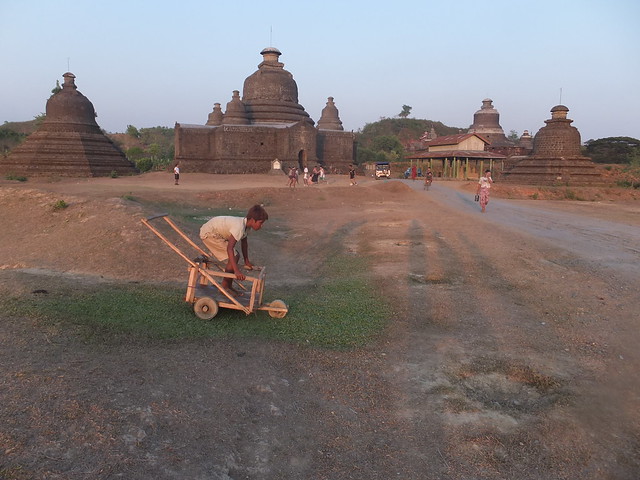 Evening at Lay-myut-hna Temple: A slope allows a young boy to ride in a water-cart whilst young men play football. Shaitthaung Temple is just visible in the background.
Evening at Lay-myut-hna Temple: A slope allows a young boy to ride in a water-cart whilst young men play football. Shaitthaung Temple is just visible in the background.
Tired, I was returned to the comfort of the Mrauk U Princess Resort and its obliging staff.
Books
'Famous Monuments of Mrauk-U' by Myar Aung (ISBN 951536172).
I purchased a copy of this useful and modestly-priced guidebook at one of the temples we visited.
'Burma's Lost Kingdoms: Splendours of Arakan' by Zaw Min Yu and Pamela Gutman (ISBN 9748304981).
I've not seen this book myself but second-hand copies are available at a price.
.
My Pictures
Mrauk U Princess Resort.
Mrauk U and its Market.
Mrauk U: Miphara-gri Temple.
Mrauk U: Koe Thaung Pagoda.
Mrauk U: Phra-ouk Pagoda.
Mrauk U: Shaitthaung Temple.
Mrauk U: Lay-myut-hna Temple
More
Next Post describing this trip.
[Revised 2-Jun-2014, 3-Jun-2014, 4-Jun-2014]
Click on any picture below to see an uncropped image.
Events of Saturday 3nd May 2014
I had a fairly leisurely start to the day with breakfast in the Strand Hotel. I had time to scan a couple of English-language Myanmar papers.
One article (which delighted me) reported that Jeremy Clarkson and the special ‘Top Gear’ program recorded in Myanmar (which I’d seen back in the U.K. before I left) were in hot water over alleged disparaging comments made during the program. I’m afraid I was unable to accept their defence that they were unaware that the language employed could be taken in a racially-critical manner.
Whilst I was getting ready, I had a message to say the lady from the local travel agents, ‘Sunbird’, was in reception. The charming young lady had slightly-revised flight times plus various vouchers for me to hand to my guide on arrival at Sittwe Airport.
Transfer by car to the Domestic Terminal at Yangon Airport was now to be at 10:15 a.m. to check in for the ‘Air KBZ’ flight K7 422 departing at 12:30. I’d packed enough clothes for three or four days into my smaller suitcase, allowing me to leave the larger suitcase in store at the Strand until my return on the 6th May. The car took a good hour to reach the airport but we’d still time in hand. They appear to have converted what was formerly the 'V.I.P. Terminal' into a significantly-improved Check-in and Departure Lounge area for ordinary passengers. Check-in was painless and then it was through security with my hand baggage (including my trusty ‘Fujitsu’ notebook computer) into the large air conditioned departure lounge now in use. There was even a flight information display screen for departures (I only found one!), allowing me to keep track of flights (public address announcements in the Domestic Terminal are only made in Burmese).
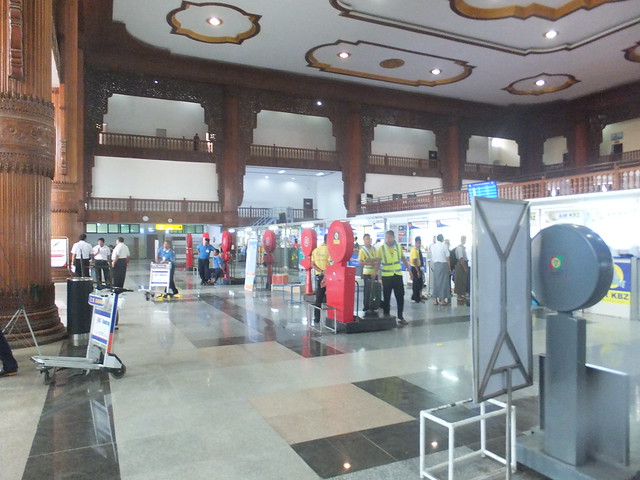 Check-in for the Sittwe flight.
Check-in for the Sittwe flight.
At the expected time, we went through the gate onto the transfer bus which took us to the ’Air KBZ’ Advanced Turbo-Prop aircraft standing on the apron. The safety briefing (in English and Burmese) included use of lifejackets for our route was likely to take us near, if not over, the sea. The boarding pass indicated an intermediate stop at ‘SDY’. I didn’t recognise the ticketing code but realised afterwards that a straight route from Yangon to Sittwe would pass very close to Thandwe airport which, confusingly, is also called Ngapali. Ngapali is a popular beach resort – I’d considered staying there but was told that the recommended resort hotel would close at the end of the ‘High’ season, shortly before my trip. The British originally called the airport at Thandwe ‘Sandway’ which explains the ticketing code. ‘Sandway’ and ‘Thandwe’ are probably British and Romanised-Burmese spellings of the same name (like ‘Rangoon’ and ‘Yangon’).
We descended towards Thandwe airport at I could see a long, very attractive, sandy beach with waves breaking. This was the Bay of Bengal.
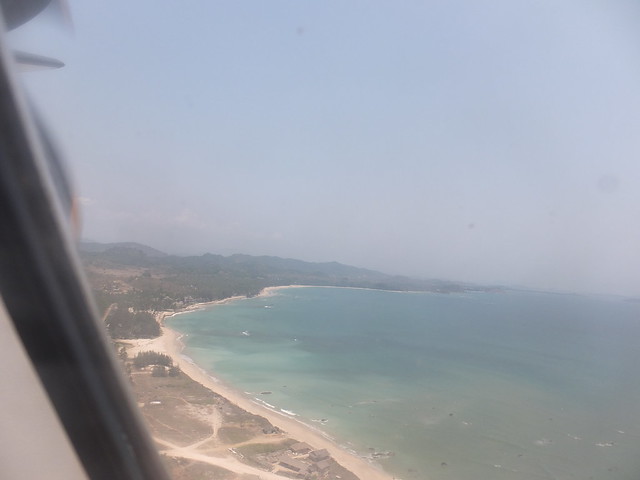 Attractive beaches visible on the approach to Thandwe Airport.
Attractive beaches visible on the approach to Thandwe Airport.
The aircraft landed and taxied to the terminal building. Ground staff erected a simple rope safety barrier around the area of the stopped port propeller before dragging out a luggage trailer with an imposing array of modern luggage, since the hatch to the baggage hold was adjacent to the propeller.
 'Joiners' luggage about to be loaded at Thandwe Airport.
'Joiners' luggage about to be loaded at Thandwe Airport.
A number of Burmese passengers disembarked, making room for what appeared to be exclusively European ‘joiners’. They looked as if they’d just come from one of the beach resorts. A German lady sat next to me. She was travelling with her husband and two teenage daughters back home, currently Hong Kong. The ground crew finally managed to load all the baggage and we were soon airborne again, destination Sittwe.
The British abandoned Mrauk U as a regional capital (it is a fair way upstream from the sea, as I was about to discover), choosing instead to develop ‘Sittway’ (British spelling) as their administrative centre. After approaching over a series of islands and fishing villages, we landed at Sittwe airport. The German lady had told me that she was not too comfortable in small aircraft so it was unfortunate that we made one of the heaviest landings I’d experienced on this trip. The European passengers seemed to be continuing to Yangon – only a few passengers got off and we were trusted to walk the few yards across the apron to the terminal building.
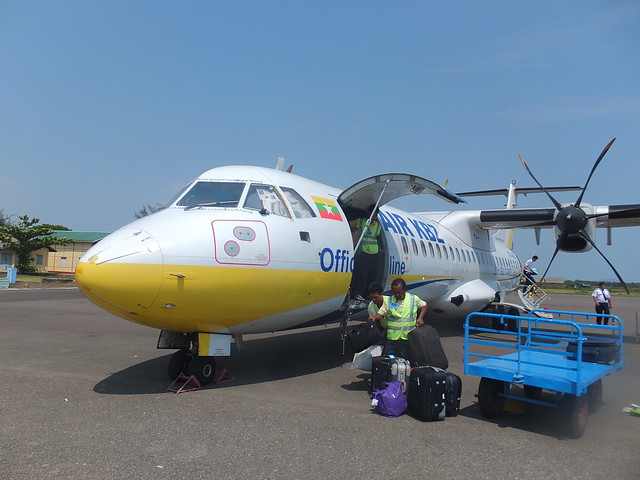 The 'Air KBZ' aircraft on arrival at Sittwe.
The 'Air KBZ' aircraft on arrival at Sittwe.
My guide was waiting and my small checked bag arrived safely.
The various States forming the Republic of the Union of Myanmar have a degree of autonomy and, since I was about to enter Rakhine State, my guide took my passport and arranged the formalities at a desk marked ‘IMMIGRATION’. A vehicle was waiting for us to take us the short drive to Sittwe town, where I’d board a private boat for the trip up river to Mrauk U. I’d no idea what sort of boat so I was wearing slacks to simplify matters although a longyi is much more comfortable.
The long, straight road took us through what was quite a busy and sizeable town (I believe the population is about 20,000), then we turned into a small ship repair yard with a covered slipway. The general air of dereliction suggested that this might have been abandoned by the British and unused since. But the glare of an electric arc welder confirmed that this was, in fact, a fully-functional, if unkempt, shipyard.
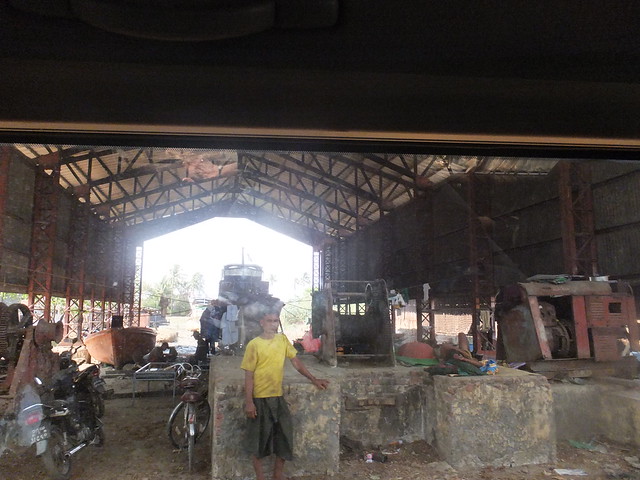 Arriving at the Ship Yard in Sittwe.
Arriving at the Ship Yard in Sittwe.
Our transport pulled up in a spot crammed with bits of boats and cargo. Various groups of people seemed to be engaged in different tasks. There was a wooden jetty thrusting into an adjacent waterway but the loose or missing planks of this twisted construction gave it more the appearance of a piece of modern art than a means of joining a boat. I’m an adherent to the dictum “If it ain’t broke, don’t fix it” myself, but the Burmese are expert in taking this philosophy to extremes. With some reservations, I carefully followed my guide across the obstacle course of the dilapidated jetty to a rather odd-looking, black-painted wooden boat. The hull had the re-assuring lines of something built by people who knew what they were doing but some curious wooden fish decorations, large circular cut-outs resembling portholes on the main deck and a wooden structure to support an awning (not fitted) on the upper deck combined to give a peculiar effect.
 Boarding the boat to Mrauk U at the Ship Yard in Sittwe.
Boarding the boat to Mrauk U at the Ship Yard in Sittwe.
As soon as I and my luggage were aboard, we cast-off and carefully manoeuvred into the very congested creek. As we went downstream, we were followed by a familiar shape - it appeared to be a larger-version of the 'Express Boat' I'd been introduced to on the Rajang River in Sarawak (described in a post here and, indeed, my guide thought the design had come from Malaysia. As the creek emptied into the sea, the 'Express Boat' (operated by Malikha Travels) opened up his engines and overtook us.
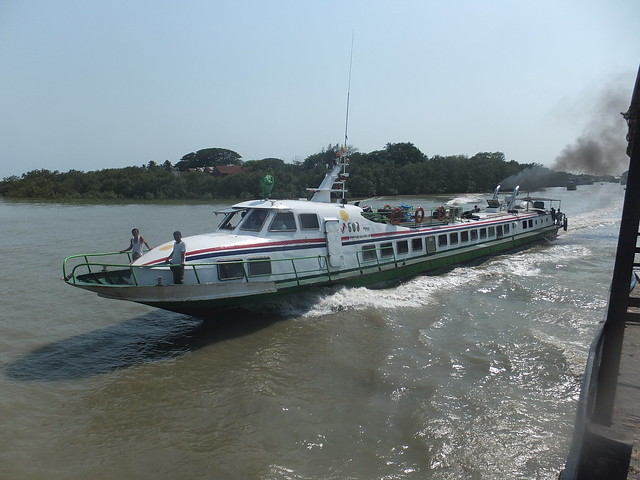 The 'Express Boat' heads for the offshore islands.
The 'Express Boat' heads for the offshore islands.
We traversed the sea for a while, keeping parallel to the shore, until we entered the broad estuary of the River Kaladan which would take us to Mrauk U and my hotel. Against the current, this would take around six hours.
There were at least three crew, all in nondescript longyi and tee shirts but with the confident gaze of boatmen everywhere. There were at least two hotel staff, in shirt and longyi which formed the hotel uniform. The one waiter sported a white jacket with black buttons, giving a very superior appearance. Then there was my guide and I finally realised that all of this effort was just for me.
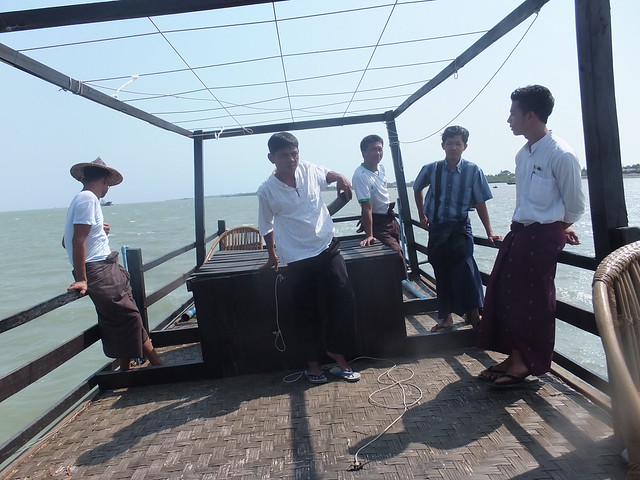 Some of the crew on the upper deck.
Some of the crew on the upper deck.
The boat was at least 40 feet long and 15 feet in the beam so it was quite spacious. Later, the hotel information informed me that these boats are “fully equipped” for 20-odd passengers and the hotel operates two or three of them. I tended to stay on the upper deck for its unrestricted views but after a while I was invited to take lunch. A small table was laid out on the main deck with a white tablecloth, flowers, heavy cutlery and a folded napkin.
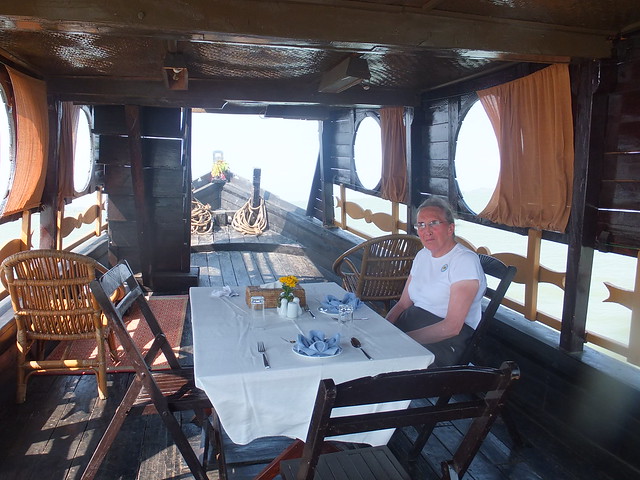 Relaxing on the main deck before lunch.
Relaxing on the main deck before lunch.
I declined both prawns and chicken and settled for steamed rice and cooked vegetables. It was delicious but I could only manage about half of the portion of rice which the Burmese consider essential for their own smaller frames.
Both river banks were farmed flatland with isolated or small groups of bamboo cottages, each with one or more traditional wooden longboats. These boats were variously propelled by a small engine driving a long propeller shaft ('longtail boat' style), by a rectangular sail or simply by paddles. Periodically, small herds of water buffalo grazed near the water's edge.
We continued upstream through a warm evening, the river meandering left and right and still quite wide. The darkness descended quite quickly, as it does in the tropics. We just kept going, occasionally with a lookout in the prow with a powerful torch swinging left and right. Then we came upon a vessel midstream and lamp signals were exchanged. As we passed, the crew of the other boat shouted and my guide explained their situation. The other boat had been taking two passengers upstream to our hotel when it lost power. From the design of the boat, it didn’t look like one of the standard hotel fleet. We circled around and gently came alongside the disabled vessel. Strong arms held the two boats together whilst luggage was transferred to our boat and then more strong arms helped the passengers scramble aboard.
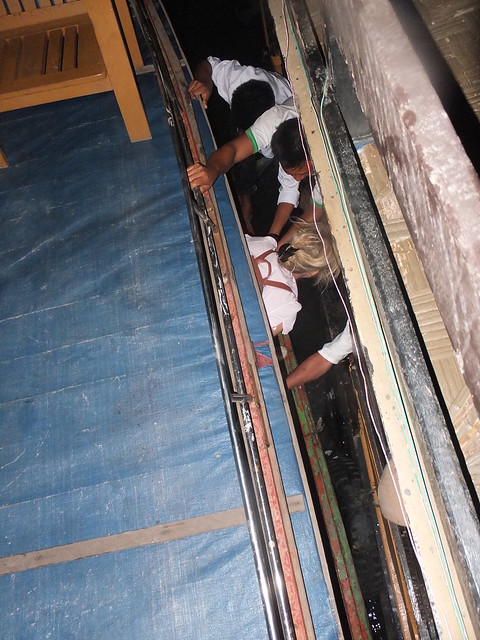 Carlotta is helped from the stranded boat (blue roof) to my boat (on the right).
Carlotta is helped from the stranded boat (blue roof) to my boat (on the right).
The couple joined me on the top deck - a middle-aged couple from Milan, Marco and Carlotta, who were very relieved that their adventure had ended. The hotel staff on my boat provided tea and coffee and we continued through the dark, at last coming to the private jetty at the Mrauk U Princess Resort.
As is often the case in this type of resort, the accommodation was in the form of individual ‘ethnic’ cottages, here in Rakhine architectural style, but with very luxurious appointments. The ‘village’ effect was somewhat spoilt by the sound of ‘Gangham Style’ being played very loud. The hotel apologised that there was a wedding at one of the houses in the village next to the resort and the reception was clearly well in progress. The disco music continued, sometimes loud, sometimes quieter, for most of the night and during the next day but I found it amusing rather than irritating. On Saturday night, I was so tired I don’t think anything would have disturbed me.
Marco and Carlotta insisted that I had been their rescuer and, despite my protests, insisted on taking me to dinner in the hotel dining room which, fortunately, stayed open to midnight. A pleasant conclusion to an interesting, if exhausting, day.
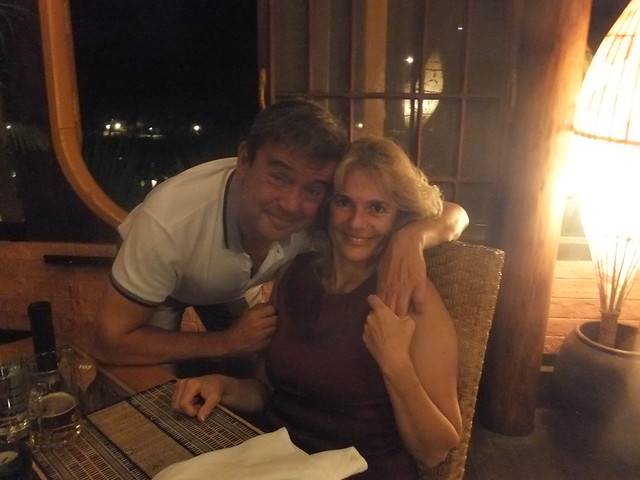 Dinner with Marco and Carlotta.
Dinner with Marco and Carlotta.
My Pictures
Yangon Airport.
Thandwe Airport.
Sittway Airport.
Sittwe, Myanmar.
By Boat to Mrauk U.
Mrauk U Princess Resort.
More
Next Post describing this trip.
[Revised 28-May-2014, 2-Jun-2014]
 The 'Jeep' and driver which took me and my guide around Mrauk U.
The 'Jeep' and driver which took me and my guide around Mrauk U.


 The second-hand clothing stall in Mrauk U market.
The second-hand clothing stall in Mrauk U market.
 The football match drew a sizeable crowd.
The football match drew a sizeable crowd.
 The two Buddha images at Miphara-gri.
The two Buddha images at Miphara-gri.
 View of the new railway under construction from Miphara-gri.
View of the new railway under construction from Miphara-gri.
 View of the Koe Thaung Pagoda from the Miphara-gri Temple.
View of the Koe Thaung Pagoda from the Miphara-gri Temple.
 The Lower Vaulted Passage at Koe-thaung, with stone relief Buddha images 9 inches tall covering the walls.
The Lower Vaulted Passage at Koe-thaung, with stone relief Buddha images 9 inches tall covering the walls.

 Shaitthaung Temple.
Shaitthaung Temple.
 One of the richly-decorated internal passages.
One of the richly-decorated internal passages.
 Statue of Shun-nge Sara U Mra Wah.
Statue of Shun-nge Sara U Mra Wah.

 Lay-myut-hna Temple
Lay-myut-hna Temple
 Evening at Lay-myut-hna Temple: A slope allows a young boy to ride in a water-cart whilst young men play football. Shaitthaung Temple is just visible in the background.
Evening at Lay-myut-hna Temple: A slope allows a young boy to ride in a water-cart whilst young men play football. Shaitthaung Temple is just visible in the background.











